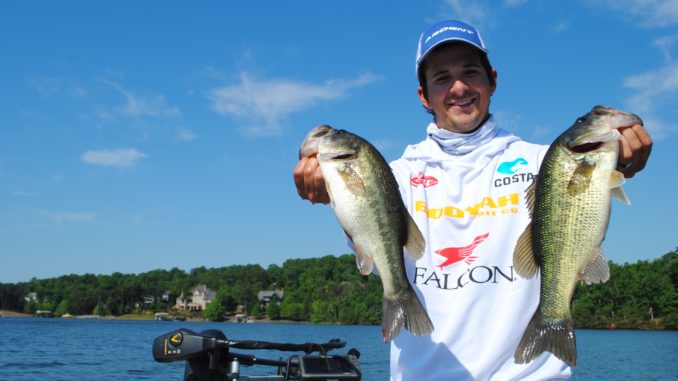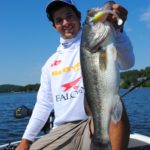
Soft-plastic swimbaits can be great summer baits for bass in the Carolinas, if you know how to rig them and fish them. Here’s how….
A soft-plastic swimbait may not be the artificial lure that a lot of bass fishermen point to as their “go-to” bait during the summer, but they’ve never been in the shoes of young bass pro Dylan Fulk of Concord, N.C.
He throws it as his primary summer bait — because everybody else in his neighborhood is throwing something else.
“A swimbait is a good way to cover a lot of water in the summer, and it’s not a crankbait,” he said. “Everybody in North Carolina throws a crankbait, and nobody really throws a swimbait, but a swimbait will get you a bigger bite, because it’s a more natural, bigger bait.
“I like to start on ’em with a swimbait, because if you hook a fish, you don’t bring the whole school with it like you do with a crankbait. You don’t educate ’em like you do with a crankbait. A swimbait doesn’t have rattles or a treble hook banging around like a crankbait.
“I think bass get educated and quit biting, so you want to catch the biggest fish in a school early, and that’s what a swimbait does. After you catch a few fish out of a school, it’s hard to get a bigger, mature fish to bite, so you want to catch that big fish first, and a swimbait is the bait to do it with.”
Fulk’s swimbaits of choice are two 5-inch soft plastics: Yum’s Money Minnow and Pulse Shad. He can rig either bait a handful of different ways, but he fishes them all the same way.
“A Money Minnow has a real, tight action, and a Pulse Shad has a skinny rear end and a real big tail kick. I’ve gotten bites on both of them. You just figure which one the fish want,” he said.
“I will throw it and let it sink all the way to the bottom, then give it a good pop to get it off the bottom and start reeling it slowly. A common misconception a lot of people have is that you work a swimbait along the bottom. The advantage of a swimbait is that it looks natural, and it’s not natural for a baitfish to go run its head into a bunch of rocks on the bottom.
“I’ll throw, let it hit bottom, pop it off and get started with a slow wind. When I’m winding, I’ll quit winding, and if the bait hits the bottom in a second, I’m confident that the bait is working just off the bottom where it should be.”
Fulk said he’ll fish a swimbait anywhere from 10 to 30 feet deep, depending on the lake he’s fishing and where bass are hanging out. He likes to fish it on a 3/4-ounce jighead, on a 7-foot-3, heavy action Falcon Cara rod with a lot of backbone, mated with an Ardent Apex Elite bait casting reel.
“Anything that weighs 3/4-ounce, with a lot of rods, you’ll have to lob it when you cast, but that rod has enough backbone to cast a heavy bait and load up when a fish hits,” he said. “The reel is important for a number of reasons. You need to be able to make long casts, and it has really big handles, which allows me to have more control over the fish when I get him on. And I never set the hook on a swimsuit fish. I just reel down on him like you would a crankbait bite.”







Be the first to comment